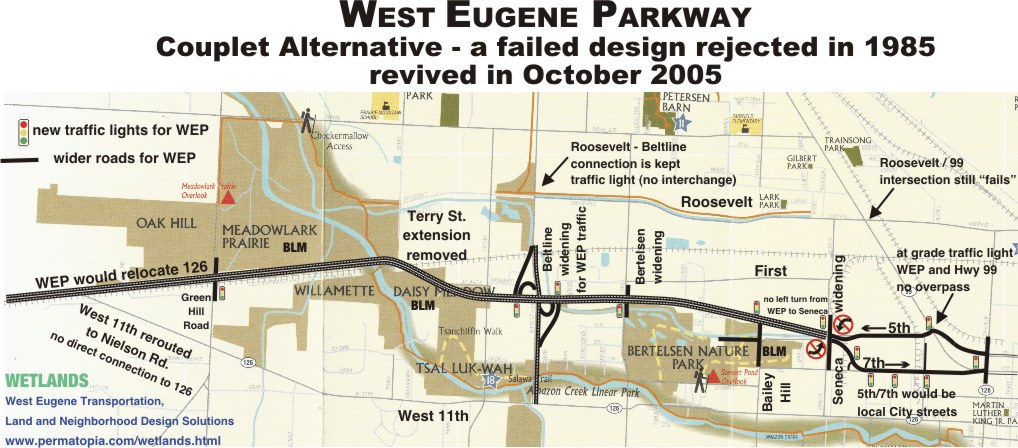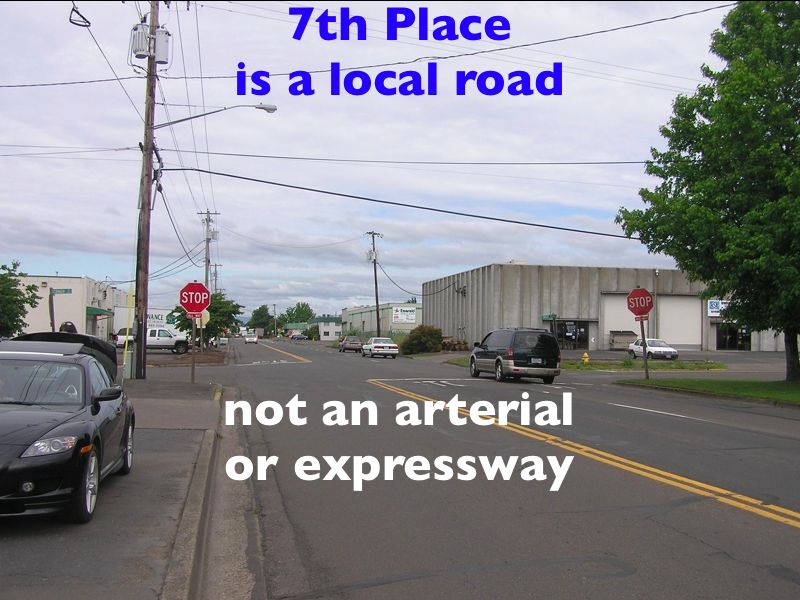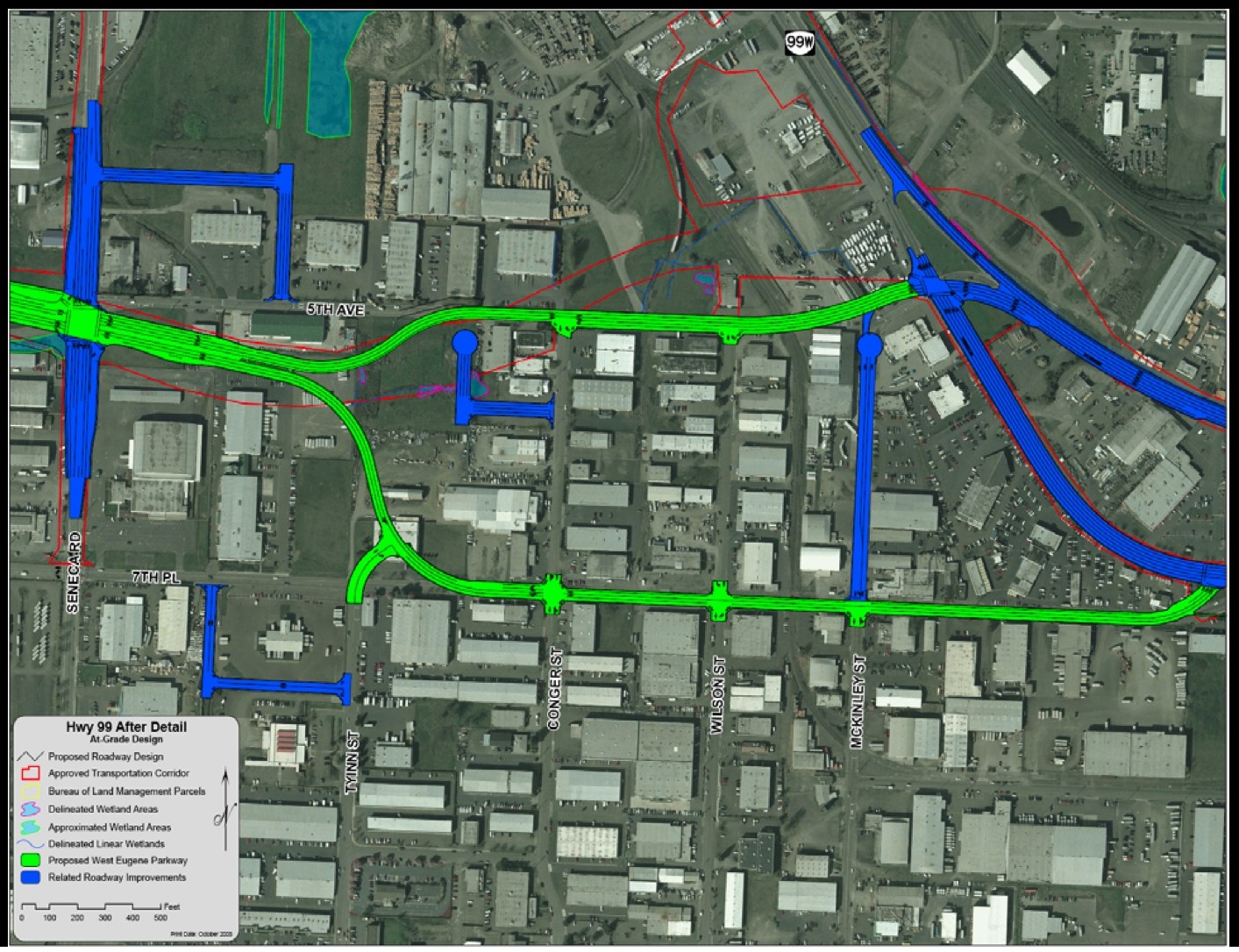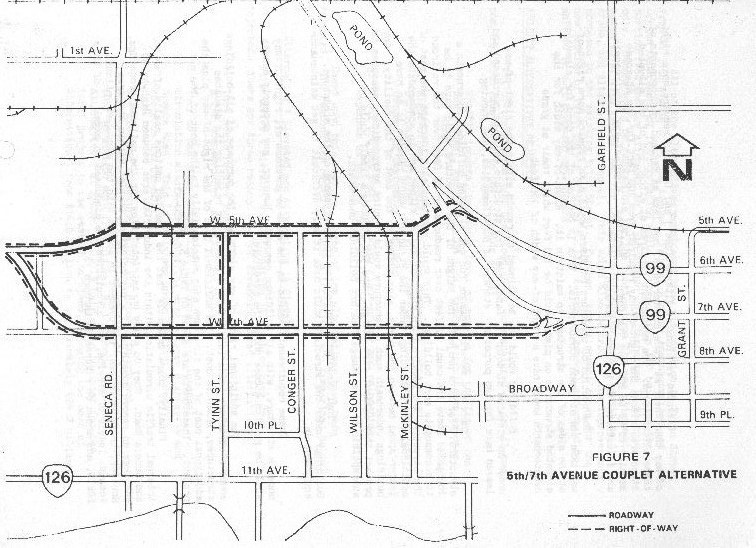Couplet alternative (2005)
ODOT revived idea they discarded in 1985 as unworkable


ODOT and Lane County employees have been vague about the number of traffic lights on this "couplet" segment, what would happen to businesses that currently have frontage access to 7th Place and other roads converted into the WEP, the train crossing of 5th (which would obstruct WEP traffic), among other issues.
Eastbound WEP would have more traffic lights between the western and eastern termini than the WETLANDS alternative, and two of the traffic lights on the WETLANDS alternative could be removed with Alternative 2 (flyover ramp westbound 11th to northbound Beltline, interchange between Roosevelt and Beltline).
Westbound WEP traffic would have about the same number of lights as the WETLANDS alternative, depending on the final designs of WEP and the WETLANDS alternative. If the WEP couplet on 5th has traffic lights to control access to local streets, this would have more light on WEP than WETLANDS. WETLANDS alternative 1 could reduce a light with a merging ramp from southbound Beltline to westbound 11th. Alternative 2 adds a light by constructing an interchange at Roosevelt (which is avoided by eastbound WETLANDS traffic. Another light could be eliminated if the West 11th / Green Hill intersection is turned into an interchange, as suggested by some ODOT literature in 2001 before the Measure 20-54 referendum (ODOT's plans in case the WEP is not built).
However, most WEP traffic would not be from point to point - the eastern part would be the most crowded segment, and this is the part that ODOT is building to the lowest design standards.
Garfield to Route 126
Eastbound WEP - 12 traffic lights
Eastbound WETLANDS Alternative 1 (no Beltline Phase 3) -
11 traffic lights
Eastbound WETLANDS Alternative 2 - (flyover ramp 11/BL, Roosevelt
Interchange) - 9 traffic lights
Westbound WEP - 7 or 9 traffic lights
Westbound WETLANDS Alternative 1 - 8 traffic lights
Westbound WETLANDS Alternative 2 - 9 traffic lights
| Official ODOT map, October 2005 |
Green is the proposed porkway route.
Blue is other construction (wider roads, road reconstruction, new roads) needed for the WEP.
Shaded blue areas are wetlands.
Red outline is the footprint of the 1997 "Modified Project" design.
No Left Turns would be allowed from WEP to Seneca northbound or southbound.

| from the 1990 Final EIS comments on Couplet alternative |
5th / 7th Avenue Couplet
This alternative would have more serious traffic and safety problems because of unrestricted access, as well as internal circulation difficulties for local businesses.
The 5th/7th couplet was dismissed in the SDEIS [1986 version]. It would have no access control on a state highway, it would have traffic and safety problems, and would result in internal circulation difficulties for businesses within the industrial area. No major public support surfaced for the couplet.
| 1986 SDEIS rejected Couplet alternative |

from the 1986 Supplemental Draft Environmental Impact Statement
Alternatives Dismissed
5th/7th Avenue Couplet
This alternative is evaluated in this SDEIS, but is also not being advanced. It would utilize W. 5th Avenue reconstructed to four travel lanes for westbound travel, and W. 7th Avenue reconstructed to four travel lanes for eastbound travel. Past Seneca Road, it would join Alternative 1.
This alternative would for each roadway have a 15-foot travel lane along the left curb, three 11-foot travel lanes, a 6-foot bikeway, 4-1/2 foot planting areas, and 5-foot sidewalks. ....
The 5th / 7th Avenue Couplet alternative has also been rejected. Because of the existing businesses located along these streets, the 5th / 7th Avenue Couplet would not have any access control. This is a state highway and unrestricted access would be detrimental to traffic flow and cause safety problems. For example, the widened streets with the couplet would make loading and unloading for businesses more difficult and much more dangerous with the greatly increased volume and speed of traffic on the new facility. This would likely result in a higher accident rate for this alternative than would be experienced with Alternative 1 at grade or Alternative 1A at grade. Large trucks loading and unloading would likely block one or more traffic lanes for periods of time which would disrupt traffic flow.
Another traffic problem relates to internal circulation within this part of the industrial area, which would be more difficult because of the one-way couplet.
Supplemental Draft Environmental Impact Statement, June 5, 1986